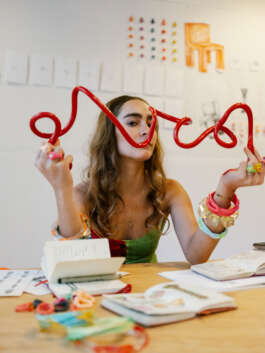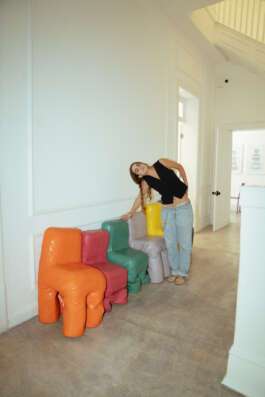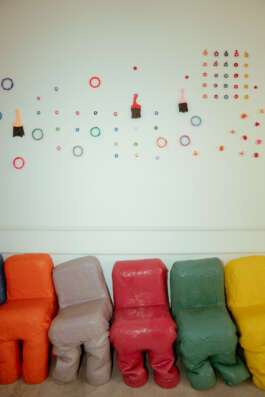



© Natelee Cocks
COLLECTIBLE In-Depth
Sofia Elias
August 2024
This series, COLLECTIBLE In-Depth, unveils the backstage of contemporary creation. Tackling various topics from personal designer processes to the position of collectible design on the global design market, COLLECTIBLE In-Depth offers different views to suit all tastes. Today we speak with Sofia Elias.
C: How did you get into collectible design? Why did you focus your practice on this type of design
rather than industrial design?
SE: I got into collectible design quite organically, starting from my thesis project where I was designing a playground that blurred the lines between architecture and sculpture. My focus was on creating a playful, sculptural environment rather than something purely functional. During that process, I began experimenting with various materials, searching for something lightweight to suit the models I was making. This experimentation led to the creation of the Blobb rings, which I initially made for myself using leftover materials. They quickly became popular, turning into a brand almost by accident.
My interest lies in the sculptural aspect rather than industrial design, which often emphasizes functionality. For me, the appeal of collectible design is the freedom it allows—each piece is unique, handmade, and carries an element of playfulness and unpredictability. This approach resonates more with my artistic vision, which often challenges conventional notions of functionality, as seen in my chairs that are deliberately designed to make you fall.
C: How do you question or challenge functionality in your design process?
SE: All my pieces challenge functionality one way or another, because we don’t use molds... this works great sometimes but sometimes I think I just want to make things more complicated for me.
For example, with the Pofi Chairs - even though they look fun, there was a long engineering process behind them. It took more than a year to develop, with lots of trial and error. I had an architect friend who was looking at the first prototypes, and said to me: I’ve figured it out, I know how to make them not collapse. And I said, No, you don’t get it, I want people to fall on them! In architecture school, they teach you that everything has to be functional. Everything I'm doing right now is not functional at all.
C: What have you been up to recently? What are the next projects/exhibitions you wish to highlight?
SE: For the past few years, I’ve been expanding my project Jugando a Jugar, a sculptural playground. This project originally began as my thesis project for school, where the research and sculptural elements I’ve been designing culminate in a proposal where play has no specific agenda, is not functional, and has no clear or known norms. Users' actions determine the use and purpose of the objects and space, rather than vice-versa, slightly altering the utilitarian, the normative, and the functional.
When users interact with the objects, creating their own interpretations and interacting with others to build a shared understanding of the play object's function, unexpected experiences and connections occur. Active participation is required, demanding a greater level of attention than what is typical of common play objects, leading users to greater self-awareness and consciousness of their presence within the situation, creating intimacy and unexpected tension between the object, the game, and its users. This project reflects on individual and collective courage, as it is expressed both creatively and socially, to create spaces with ambiguous and varied purposes in which users can interpret or re-appropriate their playground and build their own understanding of themselves as part of a community.
Many of these objects require more than one user in order to “work,” as in the example of a seesaw, requiring collaboration and interaction among those at play. Forming and being in “community” is the main “goal” of each structure. The word "seesaw" and its contrasting meaning—present and past, going up and down: you see and then saw.
What has been wonderful to see is all different types of people of all ages playing and interacting with the
sculpture.
Theme: The importance of collaboration and teamwork in recreational activities.
Inquiry at work: The role of shared experiences in fostering connections among individuals and communities.
The process of creating the sculptural playgrounds consisted of an exploration of materials, textures, and colors, resulting in a series of models and miniature sculptures, all organic in form and fluid in conception.
Simultaneously, while exploring different materials to create the models for the park, using bubblegum, glitter, and spaghetti, I created a very lightweight material that later became the main material for the Blobb rings I created. In 2019, I launched my ephemeral “miniature sculptures for the body,” Blobb, which is an extension of my practice and an experimentation with form and matter on a miniature scale.

© Sofia Elias, Pofi Chairs, 2024

© Sofia Elias, Pofi Chairs, 2024

© Natelee Cocks
COLLECTIBLE In-Depth
Sofia Elias
August 2024
This series, COLLECTIBLE In-Depth, unveils the backstage of contemporary creation. Tackling various topics from personal designer processes to the position of collectible design on the global design market, COLLECTIBLE In-Depth offers different views to suit all tastes. Today we speak with Sofia Elias.
C: How did you get into collectible design? Why did you focus your practice on this type of design
rather than industrial design?
SE: I got into collectible design quite organically, starting from my thesis project where I was designing a playground that blurred the lines between architecture and sculpture. My focus was on creating a playful, sculptural environment rather than something purely functional. During that process, I began experimenting with various materials, searching for something lightweight to suit the models I was making. This experimentation led to the creation of the Blobb rings, which I initially made for myself using leftover materials. They quickly became popular, turning into a brand almost by accident.
My interest lies in the sculptural aspect rather than industrial design, which often emphasizes functionality. For me, the appeal of collectible design is the freedom it allows—each piece is unique, handmade, and carries an element of playfulness and unpredictability. This approach resonates more with my artistic vision, which often challenges conventional notions of functionality, as seen in my chairs that are deliberately designed to make you fall.
C: How do you question or challenge functionality in your design process?
SE: All my pieces challenge functionality one way or another, because we don’t use molds... this works great sometimes but sometimes I think I just want to make things more complicated for me.
For example, with the Pofi Chairs - even though they look fun, there was a long engineering process behind them. It took more than a year to develop, with lots of trial and error. I had an architect friend who was looking at the first prototypes, and said to me: I’ve figured it out, I know how to make them not collapse. And I said, No, you don’t get it, I want people to fall on them! In architecture school, they teach you that everything has to be functional. Everything I'm doing right now is not functional at all.
C: What have you been up to recently? What are the next projects/exhibitions you wish to highlight?
SE: For the past few years, I’ve been expanding my project Jugando a Jugar, a sculptural playground. This project originally began as my thesis project for school, where the research and sculptural elements I’ve been designing culminate in a proposal where play has no specific agenda, is not functional, and has no clear or known norms. Users' actions determine the use and purpose of the objects and space, rather than vice-versa, slightly altering the utilitarian, the normative, and the functional.
When users interact with the objects, creating their own interpretations and interacting with others to build a shared understanding of the play object's function, unexpected experiences and connections occur. Active participation is required, demanding a greater level of attention than what is typical of common play objects, leading users to greater self-awareness and consciousness of their presence within the situation, creating intimacy and unexpected tension between the object, the game, and its users. This project reflects on individual and collective courage, as it is expressed both creatively and socially, to create spaces with ambiguous and varied purposes in which users can interpret or re-appropriate their playground and build their own understanding of themselves as part of a community.
Many of these objects require more than one user in order to “work,” as in the example of a seesaw, requiring collaboration and interaction among those at play. Forming and being in “community” is the main “goal” of each structure. The word "seesaw" and its contrasting meaning—present and past, going up and down: you see and then saw.
What has been wonderful to see is all different types of people of all ages playing and interacting with the
sculpture.
Theme: The importance of collaboration and teamwork in recreational activities.
Inquiry at work: The role of shared experiences in fostering connections among individuals and communities.
The process of creating the sculptural playgrounds consisted of an exploration of materials, textures, and colors, resulting in a series of models and miniature sculptures, all organic in form and fluid in conception.
Simultaneously, while exploring different materials to create the models for the park, using bubblegum, glitter, and spaghetti, I created a very lightweight material that later became the main material for the Blobb rings I created. In 2019, I launched my ephemeral “miniature sculptures for the body,” Blobb, which is an extension of my practice and an experimentation with form and matter on a miniature scale.

© Sofia Elias, Pofi Chairs, 2024

© Sofia Elias, Pofi Chairs, 2024
Contact
info@collectible.design
VIP PORTAL
EXHIBITOR PORTAL
PRIVACY POLICY
© 2025 Collectible
Contact
info@collectible.design
VIP PORTAL
EXHIBITOR PORTAL
PRIVACY POLICY
© 2025 Collectible